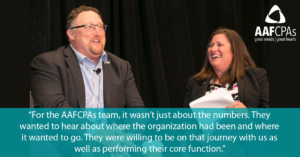A Partnership in Charting a Sustainable Future
AAFCPAs evaluated the organization’s financial and operational position and helped illuminate avenues for growth.
How Did One Nonprofit Explore Creative Approaches to a Sustainable Model?
For nonprofits, charting the future is complex. The search for creative, strategic approaches to sustainability is continuous, and many organizations have struggled to achieve long term, mission-aligned profitability.
In its work with MENTOR: The National Mentoring Partnership, AAFCPAs evaluated the organization’s financial and operational position and helped illuminate avenues for growth.
Their work together led to an improved outlook, an expansion of the organization’s impact, and a new chapter sparked by positive momentum.
Background
 When MENTOR was founded in 1990, its mission was groundbreaking: the organization built a national movement to foster relationships between at-risk children and adults. MENTOR was a pioneer in the field, providing standards, training, advocacy, and public awareness through its national network of affiliates.
When MENTOR was founded in 1990, its mission was groundbreaking: the organization built a national movement to foster relationships between at-risk children and adults. MENTOR was a pioneer in the field, providing standards, training, advocacy, and public awareness through its national network of affiliates.
Their programs made a significant impact, but success brought new challenges. Mentoring as a discipline became more mainstream, new programs proliferated, and MENTOR’s mission and delivery model needed to keep pace in order to thrive.
MENTOR brought on new leadership, CEO David Shapiro, to seek solutions. The urgency was clear: to survive long term, the organization needed to recapture its original entrepreneurial spirit and rethink its relevance in this new environment.
Part of Mr. Shapiro’s process was to take a forensic approach to spending control, performing a deep analysis into which investments were productive, which posed unnecessary risks, and how they might develop more reliable revenue. He and MENTOR’s Chief Finance and Administrative Officer, Beth Tallarico, turned to AAFCPAs to help provide an objective, outside perspective.
Obstacles & Challenges
With MENTOR’s original model in question, the organization knew it needed a change in direction. There were a number of issues to contend with:
- MENTOR needed to re-assess the needs of the wider marketplace in the context of its mission. There is no doubt that the model was valuable when mentoring was a younger field, but the new climate required a different approach to stay relevant.
- There was internal skepticism about the organization’s ability to continue to successfully fundraise under the current model. How could MENTOR be successful as an organization that made its name serving as an intermediary, when plenty of self-sufficient programs had now emerged? They needed to go back out into the world to investigate how they could be most valuable to their constituents.
- Going one step further, MENTOR’s development efforts were falling into a common trap. They became overly reliant on financial commitments from a few dedicated Board members. This led to a concentration of fundraising that presented significant risk. As AAFCPAs noted, this trend could have led the organization to lose its nonprofit status, shifting closer to the definition of a private foundation.
Solutions
With a global objective to add value, AAFCPAs went beyond the traditional core function of an auditor, getting the full picture of challenges, vision and the evolution of the organization both historically and in real time.
Read more about how MENTOR explored new avenues, remained attentive to risks, and geared its model for responsible growth. Download the full Client Success Story, which also features video clips of Shapiro sharing stories of adaptability in the pursuit of long-term financial and programmatic sustainability.>>

